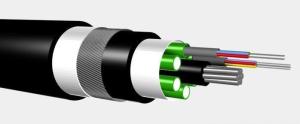Quote of the Day
A hero is someone who has given his or her life to something bigger than oneself.
— Joseph Campbell
Introduction
A physicist in my group and I were having a discussion about how the wavelengths (i.e. colors) for lasers are specified by an international standard and I thought this discussion would provide a nice example of a differential approximation. The widespread deployment of fiber optic cable (see Figure 1, Wikipedia) is a game changer for networking and may be our most important new infrastructure -- remember that high-speed wireless depends on cell towers interconnected with fiber optic cables.
Analysis
Fiber optic cable is an incredible media for transmitting light. We are greatly increasing the amount of information that we can transfer over fiber by adding additional wavelengths of light onto the fiber. Our discussion this morning centered on the Dense Wavelength Division Multiplexing (DWDM) wavelengths specified in ITU-T G.694.1. This standard specifies laser wavelengths in terms of a frequency grid. Adjacent wavelengths in the grid are separated in frequency by 100 GHz. Each wavelength is referred to as a channel.
I normally think of light in terms of wavelength and not frequency. The wavelength and frequency of light are related by Equation 1.
| Eq. 1 |
where
- λ is wavelength of the light channel.
- ν is is the frequency of the light channel.
- c is speed of light in a vacuum.
I have seen engineers use Equation 2 to approximate the wavelength difference between two wavelengths separated by a defined frequency difference.
| Eq. 2 |
where
- dν is is the frequency difference between adjacent wavelengths.
As you can see from Equation 2, holding the frequency difference between adjacent λ's constant means that dλ will vary for each wavelength. I have seen engineers incorrectly assume that the dλ is constant for all wavelengths -- not true -- only the frequency difference is fixed.
Using Mathcad, we can easily compute the wavelengths associated with each frequency (Figure 2).
I have included that actual grid specification in Appendix A. It is identical to what I generated in Mathcad.
Conclusion
Just a quick post to illustrate a quick use of differentials.
Appendix A: ITU 100 GHz Frequency Grid.
Table 1: ITU 100 GHz Frequency Grid.
| Channel | Frequency (GHz) | Wavelength (nm) |
| 1 | 190,100 | 1577.03 |
| 2 | 190,200 | 1576.2 |
| 3 | 190,300 | 1575.37 |
| 4 | 190,400 | 1574.54 |
| 5 | 190,500 | 1573.71 |
| 6 | 190,600 | 1572.89 |
| 7 | 190,700 | 1572.06 |
| 8 | 190,800 | 1571.24 |
| 9 | 190,900 | 1570.42 |
| 10 | 191,000 | 1569.59 |
| 11 | 191,100 | 1568.77 |
| 12 | 191,200 | 1567.95 |
| 13 | 191,300 | 1567.13 |
| 14 | 191,400 | 1566.31 |
| 15 | 191,500 | 1565.5 |
| 16 | 191,600 | 1564.68 |
| 17 | 191,700 | 1563.86 |
| 18 | 191,800 | 1563.05 |
| 19 | 191,900 | 1562.23 |
| 20 | 192,000 | 1561.42 |
| 21 | 192,100 | 1560.61 |
| 22 | 192,200 | 1559.79 |
| 23 | 192,300 | 1558.98 |
| 24 | 192,400 | 1558.17 |
| 25 | 192,500 | 1557.36 |
| 26 | 192,600 | 1556.55 |
| 27 | 192,700 | 1555.75 |
| 28 | 192,800 | 1554.94 |
| 29 | 192,900 | 1554.13 |
| 30 | 193,000 | 1553.33 |
| 31 | 193,100 | 1552.52 |
| 32 | 193,200 | 1551.72 |
| 33 | 193,300 | 1550.92 |
| 34 | 193,400 | 1550.12 |
| 35 | 193,500 | 1549.32 |
| 36 | 193,600 | 1548.51 |
| 37 | 193,700 | 1547.72 |
| 38 | 193,800 | 1546.92 |
| 39 | 193,900 | 1546.12 |
| 40 | 194,000 | 1545.32 |
| 41 | 194,100 | 1544.53 |
| 42 | 194,200 | 1543.73 |
| 43 | 194,300 | 1542.94 |
| 44 | 194,400 | 1542.14 |
| 45 | 194,500 | 1541.35 |
| 46 | 194,600 | 1540.56 |
| 47 | 194,700 | 1539.77 |
| 48 | 194,800 | 1538.98 |
| 49 | 194,900 | 1538.19 |
| 50 | 195,000 | 1537.4 |
| 51 | 195,100 | 1536.61 |
| 52 | 195,200 | 1535.82 |
| 53 | 195,300 | 1535.04 |
| 54 | 195,400 | 1534.25 |
| 55 | 195,500 | 1533.47 |
| 56 | 195,600 | 1532.68 |
| 57 | 195,700 | 1531.9 |
| 58 | 195,800 | 1531.12 |
| 59 | 195,900 | 1530.33 |
| 60 | 196,000 | 1529.55 |
| 61 | 196,100 | 1528.77 |
| 62 | 196,200 | 1527.99 |
| 63 | 196,300 | 1527.22 |
| 64 | 196,400 | 1526.44 |
| 65 | 196,500 | 1525.66 |
| 66 | 196,600 | 1524.89 |
| 67 | 196,700 | 1524.11 |
| 68 | 196,800 | 1523.34 |
| 69 | 196,900 | 1522.56 |
| 70 | 197,000 | 1521.79 |
| 71 | 197,100 | 1521.02 |
| 72 | 197,200 | 1520.25 |
| 73 | 197,300 | 1519.48 |


